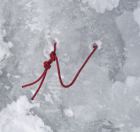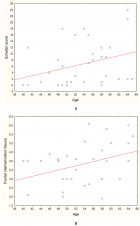Abstract
Research Article
Use of the Reverse Transcription-Polymerase Chain Reaction for differential detection of two lineages of the canine distemper virus in Chile
Bolívar P, Céspedes PF and Navarro C*
Published: 04 March, 2019 | Volume 3 - Issue 1 | Pages: 005-013
Worldwide, Canine Distemper Virus (CDV) infection is a highly prevalent disease with high morbidity and mortality. CDV causes a multisystemic disease in a wide range of hosts including 9 families of mammals among them some primates, cetaceans and numerous carnivores. It presents a high tropism for lymphoid, neurological and epithelial tissue, leading to an infection of almost all systems, so the clinical signs observed are very varied. The diagnosis is made based on the clinical presentation of the disease, which considers a variety of signs and must be confirmed by a laboratory diagnostic method. The molecular technique called Reverse Transcription Polymerase Chain Reaction (RT-PCR) has been used to characterize viral strains based on the basis of genetic differences on the hemagglutinin (H) gene of CDV has allowed the identification of 14 circulating lineages in the world. Two lineages, namely the America-1 and the Europe-1/South America-1 have been described in Chile. The goal of this work was to implement a multiplex RT-PCR protocol, which was built on the in silico design of primers based on the H gene nucleotide sequences stored in the Genbank® database. This method was capable of detecting the previously described two circulating genetic lineages of CDV in a differential way providing a supporting diagnostic tool for epidemiological studies in the country. These results suggest that the primers described here are extremely selective for the above-mentioned lineages. In addition, our initial screening indicated that most analyzed clinical samples corresponded to the America-1 lineage, stressing the need for a continuous surveillance in order to properly address the prevalence of both lineages in Chile.
Read Full Article HTML DOI: 10.29328/journal.ivs.1001014 Cite this Article Read Full Article PDF
Keywords:
RT-PCR; Hemagglutinin; H gene; America-1; Europe-1/South America-1; Canine distemper virus
References
- Vito Martella DVM, Gabrielle Elia DVM, Canio Buonavoglia DVM. Canine Distemper Virus. Vet Clin North Am Small Anim Pract. 2008; 38: 787-797. Ref.: https://goo.gl/knwvHW
- Maclachlan N, Dubovi EJ. Paramyxoviridae. In: Fenner’s Veterinary Virology. 4ª edición. Academic Press. Londres Inglaterra. 2011; 299–325. Ref.: https://goo.gl/n9VN2R
- International Committee on Taxonomy of Viruses. Virus Taxonomy. 2017; Ref.: https://goo.gl/E5PGXZ
- Sarute N, Calderón MG, Pérez R, La Torre J, Hernández M, et al. The fusion protein signal-peptide-coding region of canine distemper virus: a useful tool for phylogenetic reconstruction and lineage identification. PLOS One. 2013; 8: 1-6. Ref.: https://goo.gl/Q5qWmV
- Panzera Y, Calderón MG, Sarute N, Guasco S, Cardeillac A, et al. Evidence of two co-circulating genetic lineages of canine distemper virus in South America. Virus Res. 2012; 163: 401-404. Ref.: https://goo.gl/CPXcht
- Sarute N, Pérez R, Aldaz J, Alfieri AA, Alfieri AF, et al. Molecular typing of canine distemper virus strains reveals the presence of a new genetic variant in South America. Virus Genes. 2014; 48: 474-478. Ref.: https://goo.gl/FkLncF
- Bi Z, Wang Y, Wang X, Xia X. Phylogenetic analysis of canine distemper virus in domestic dogs in Nanging, China. Arch Virol 160: 523-527. Ref.: https://goo.gl/bnhL2g
- Fischer CDB, Gräf T, Ikuta N, Lehmann FKM, Passos DT et al. Phylogenetic analysis of canine distemper virus in South America clade 1 reveals unique molecular signatures of the local epidemic. Infect Genet Evol. 2016; 41:135-141. Ref.: https://goo.gl/ih2hNR
- Beineke A, Puff C, Seehusen F, Baumgärtner W. Pathogenesis and immunopathology of systemic and nervous canine distemper. Vet Immunol Immunopathol. 2009; 127: 1-18. Ref.: https://goo.gl/BpFMLZ
- Espinal MA, Díaz FJ, Ruiz-Saenz J. Phylogenetic evidence of a new canine distemper virus lineage among domestic dogs in Colombia, South America. Vet Microbiol. 2014; 172: 168-176. Ref.: https://goo.gl/RVzAts
- Beineke A, Baumgärtner W, Wohlsein P. Cross-species transmission of canine distemper virus – an update. One Health. 2015; 1: 49-59. Ref.: https://goo.gl/svn7Sp
- Moreira R, Stutzin M. Estudio de la Mortalidad de Zorros en la IV Región. Boletín Veterinario Oficial N°3. Servicio Agrícola Ganadero, División de Protección Pecuaria, Chile. 2005; 1-8. Ref.: https://goo.gl/gHmeuh
- Jara C, Matus P, Moreira R. Distemper canino en Isla Robinson Crusoe (Archipiélago Juan Fernández, V Región): antecedentes de un brote epidémico, 2007. Boletín Veterinario Oficial N°8. Servicio Agrícola Ganadero, División de Protección Pecuaria, Chile. 2007; 1-19. Ref.: https://goo.gl/wZfGWR
- Berríos P, Pincheira B. Distemper canino y su impacto en la fauna silvestre. Científica. 2016; 13: 137-148. Ref.: https://goo.gl/RTe6nV
- Sykes J. Canine Distemper Virus Infection. In: Canine and Feline Infectious Diseases. Elsevier Health Sciences. London, England. 2014; 152-165. Ref.: https://goo.gl/GmRz6G
- Zhao J, Shi N, Sun Y, Martella V, Nikolin V, et al. Pathogenesis of canine distemper virus in experimentally infected racoon dogs, foxes, and minks. Antivir Res. 2015; 122: 1-11. Ref.: https://goo.gl/9U1iua
- Pinotti M, Gollan A, Delgado A, Passeggi C, Occhi H, et al. Distemper canino. Fave. 2009; 8: 29-45. Ref.: https://goo.gl/v9D1ry
- Castilho J, Brandão P, Carnieli P, Oliveira R, Macedo C, et al. Molecular analysis of the N gene of canine Distemper virus in dogs in Brazil. Arq Bras de Med Vet Zootec. 2007; 59: 654-659. Ref.: https://goo.gl/h1dt5z
- Bosco E. Distemper canino. In: Retamal P, Ábalos P, Fredes F. Enfermedades animales producidas por agentes biológicos. Editorial Universitaria. Chile. 2010; 152-156. Ref.: https://goo.gl/9Mp46g
- Muñoz C. Diagnóstico molecular del virus distemper canino mediante la reacción en cadena de la polimerasa asociada a transcripción inversa del gen de la proteína de la nucleocápside viral. Memoria de Título Médico Veterinario. Santiago, Chile. U. Chile, Fac. Medicina Veterinaria. 2013; 32. Ref.: https://goo.gl/RuXfQy
- Ke GM, Ho C, Chiang M, Sanno-Duanda B, Chung C, et al. Phylodynamic analysis of the canine distemper virus hemagglutinin gene. BMC Vet Res. 2015; 11:164. Ref.: https://goo.gl/YybDk2
- Salas V, Pizarro J, Navarro C. Phylogenetic analysis of canine distemper virus detected in Chile. International Journal of Current Research. 2018; 10: 72402-72407. Ref.: https://goo.gl/GG4qTm
Figures:

Figure 1

Figure 2

Figure 3
Similar Articles
-
Canine Distemper Virus detection based in Hemaglutinine Gene as target in Reverse Transcriptase-Polymerase Chain ReactionJara P,Céspedes P,Navarro C*. Canine Distemper Virus detection based in Hemaglutinine Gene as target in Reverse Transcriptase-Polymerase Chain Reaction. . 2018 doi: 10.29328/journal.ivs.1001012; 2: 034-041
-
Use of the Reverse Transcription-Polymerase Chain Reaction for differential detection of two lineages of the canine distemper virus in ChileBolívar P,Céspedes PF,Navarro C*. Use of the Reverse Transcription-Polymerase Chain Reaction for differential detection of two lineages of the canine distemper virus in Chile. . 2019 doi: 10.29328/journal.ivs.1001014; 3: 005-013
Recently Viewed
-
Pulmonary Infarction Mimicking An Aspergilloma In A Heart Transplant RecipientAntonacci F*,Belliato M,Bortolotto C,Di Perna D,Dore R,Orlandoni G,D’Armini AM. Pulmonary Infarction Mimicking An Aspergilloma In A Heart Transplant Recipient . J Clin Med Exp Images. 2017: doi: 10.29328/journal.jcmei.1001002; 1: 005-006
-
Recurrent Peripheral Ameloblastoma of the Mandible: A Case ReportAngela Jordão Camargo*,Mayara Cheade,Celso Martinelli,Plauto Christopher Aranha Watanabe. Recurrent Peripheral Ameloblastoma of the Mandible: A Case Report. J Clin Med Exp Images. 2017: doi: 10.29328/journal.jcmei.1001003; 1: 007-010
-
The Risk Factors for Ankle Sprain in Cadets at a Male Military School in Iran: A Retrospective Case-control StudyFarzad Najafipour*,Farshad Najafipour,Mohammad Hassan Majlesi,Milad Darejeh. The Risk Factors for Ankle Sprain in Cadets at a Male Military School in Iran: A Retrospective Case-control Study. J Clin Med Exp Images. 2017: doi: 10.29328/journal.jcmei.1001005; 1: 020-026
-
Magnetic Resonance Imaging Can Detect Symptomatic Patients with Facet Joint Pain. A Retrospective AnalysisWolfgang Freund*,Frank Weber,Reinhard Meier,Stephan Klessinger. Magnetic Resonance Imaging Can Detect Symptomatic Patients with Facet Joint Pain. A Retrospective Analysis. J Clin Med Exp Images. 2017: doi: 10.29328/journal.jcmei.1001006; 1: 027-036
-
Secondary Onychomycosis Development after Cosmetic Procedure-Case ReportMariusz Dyląg*,Emilia Flisowska,Patryk Bielecki,Maria Kozioł-Gałczyńska,Weronika Jasińska. Secondary Onychomycosis Development after Cosmetic Procedure-Case Report . J Clin Med Exp Images. 2017: doi: 10.29328/journal.jcmei.1001007; 1: 037-045
Most Viewed
-
Impact of Latex Sensitization on Asthma and Rhinitis Progression: A Study at Abidjan-Cocody University Hospital - Côte d’Ivoire (Progression of Asthma and Rhinitis related to Latex Sensitization)Dasse Sery Romuald*, KL Siransy, N Koffi, RO Yeboah, EK Nguessan, HA Adou, VP Goran-Kouacou, AU Assi, JY Seri, S Moussa, D Oura, CL Memel, H Koya, E Atoukoula. Impact of Latex Sensitization on Asthma and Rhinitis Progression: A Study at Abidjan-Cocody University Hospital - Côte d’Ivoire (Progression of Asthma and Rhinitis related to Latex Sensitization). Arch Asthma Allergy Immunol. 2024 doi: 10.29328/journal.aaai.1001035; 8: 007-012
-
Causal Link between Human Blood Metabolites and Asthma: An Investigation Using Mendelian RandomizationYong-Qing Zhu, Xiao-Yan Meng, Jing-Hua Yang*. Causal Link between Human Blood Metabolites and Asthma: An Investigation Using Mendelian Randomization. Arch Asthma Allergy Immunol. 2023 doi: 10.29328/journal.aaai.1001032; 7: 012-022
-
An algorithm to safely manage oral food challenge in an office-based setting for children with multiple food allergiesNathalie Cottel,Aïcha Dieme,Véronique Orcel,Yannick Chantran,Mélisande Bourgoin-Heck,Jocelyne Just. An algorithm to safely manage oral food challenge in an office-based setting for children with multiple food allergies. Arch Asthma Allergy Immunol. 2021 doi: 10.29328/journal.aaai.1001027; 5: 030-037
-
Snow white: an allergic girl?Oreste Vittore Brenna*. Snow white: an allergic girl?. Arch Asthma Allergy Immunol. 2022 doi: 10.29328/journal.aaai.1001029; 6: 001-002
-
Cytokine intoxication as a model of cell apoptosis and predict of schizophrenia - like affective disordersElena Viktorovna Drozdova*. Cytokine intoxication as a model of cell apoptosis and predict of schizophrenia - like affective disorders. Arch Asthma Allergy Immunol. 2021 doi: 10.29328/journal.aaai.1001028; 5: 038-040

If you are already a member of our network and need to keep track of any developments regarding a question you have already submitted, click "take me to my Query."

















































































































































